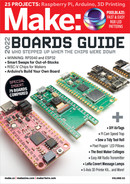
piece of paper. Then I photographed my paper
pattern and traced over it in Adobe Illustrator.
2. CUT FABRIC PATTERN PIECES
Iron the fabric and cut out the pattern pieces
(Figure
B
). I made two of these tool rolls at once,
so I cut the pieces out of two colors and mixed
and matched the pieces. All the pieces fit on a
folded length of 45"-wide fabric less than one
yard long, but half a yard is too little. Take care
about right sides and wrong sides if your fabric
has them (my canvas is the same on both sides).
You should have the following pieces (Figure
C
):
• Main body rectangle
• Two trapezoidal pocket/flaps
• Two rectangular pieces for the zipper pocket
(one skinny, one wide)
• One long piece for the strap
3. IRON AND TOPSTITCH
THE INNER LAYERS
Next up there’s a little prep ironing for some of
the raw edges. The top flap gets a double-folded
edge since we’ll see both sides of it, while the
tool holder piece only needs one fold at the top
and the short end. The strap also gets ironed with
edges to the center and then in half once more.
On the tool flap, iron the three loose edges over
twice and then topstitch the foldover to create a
nice edge.
On the tool pocket, iron the top and left edges
over once and topstitch. These edges will not be
captured by a future seam, but we won’t see the
other side of them either.
Also topstitch along the length of the tie strap
(Figure
D
).
4. INSTALL THE ZIPPER
Install the metal zipper (Figure
E
) between the
two rectangular pocket pieces, sewing right sides
together before ironing the seams open and
topstitching along the zipper to finish it up. I use
a special zipper foot on my sewing machine that
can stitch up close to the zipper.
TIP: If you’ve never sewed a zipper before, refer to
Mikaela Holmes’s excellent guide at instructables.
com/Sewing-Zippers-and-Buttons.
J
K
5. FINAL ASSEMBLY
Now all the parts are ready to be assembled.
First, attach the front to the back. Pin/clip the
pieces together, right sides facing, and stitch
around the whole perimeter (Figure
F
).
Then turn everything right side out, iron, and
topstitch around the whole thing, including across
the top of the zip pocket (Figure
G
)
. You don’t
have to topstitch around the outer edges of the zip
pocket if you don’t want to (this does reduce the
pocket capacity slightly).
Next, stitch the short edge of the tool pockets
(Figure
H
)
. The distribution of the tool dividers
is completely up to you — you can customize the
pocket widths to accommodate your specific
tool needs.
Lastly, stitch the strap in place on the outside
wherever you like, depending on which way
you prefer to roll it up (Figure
I
). I sewed the
midpoint of the strap to align with the top seam of
the zip pocket.
6. WAX ON!
Adding wax to the fabric makes it water-resistant
and more durable. It’s an optional step depending
on how you want to use your tool roll. For
motorcyclists, it’s super important to keep your
tools dry. For drawing, maybe you don’t need the
wax to protect your pencils.
There are two ways to apply fabric wax. Either
way, use a scrap piece of cardboard to protect
your work surface from the wax. If you buy the
bar type, you can just rub it on and melt it in with
a heat gun (Figures
J
and
K
). This method is
a little slow and provides an arm workout. You
build up the desired amount of wax with multiple
applications.
The other way is to melt the wax in a double
59
make.co
M83_056-60_WaxCanvasTool_F1.indd 59M83_056-60_WaxCanvasTool_F1.indd 59 10/10/22 2:27 PM10/10/22 2:27 PM
..................Content has been hidden....................
You can't read the all page of ebook, please click here login for view all page.
